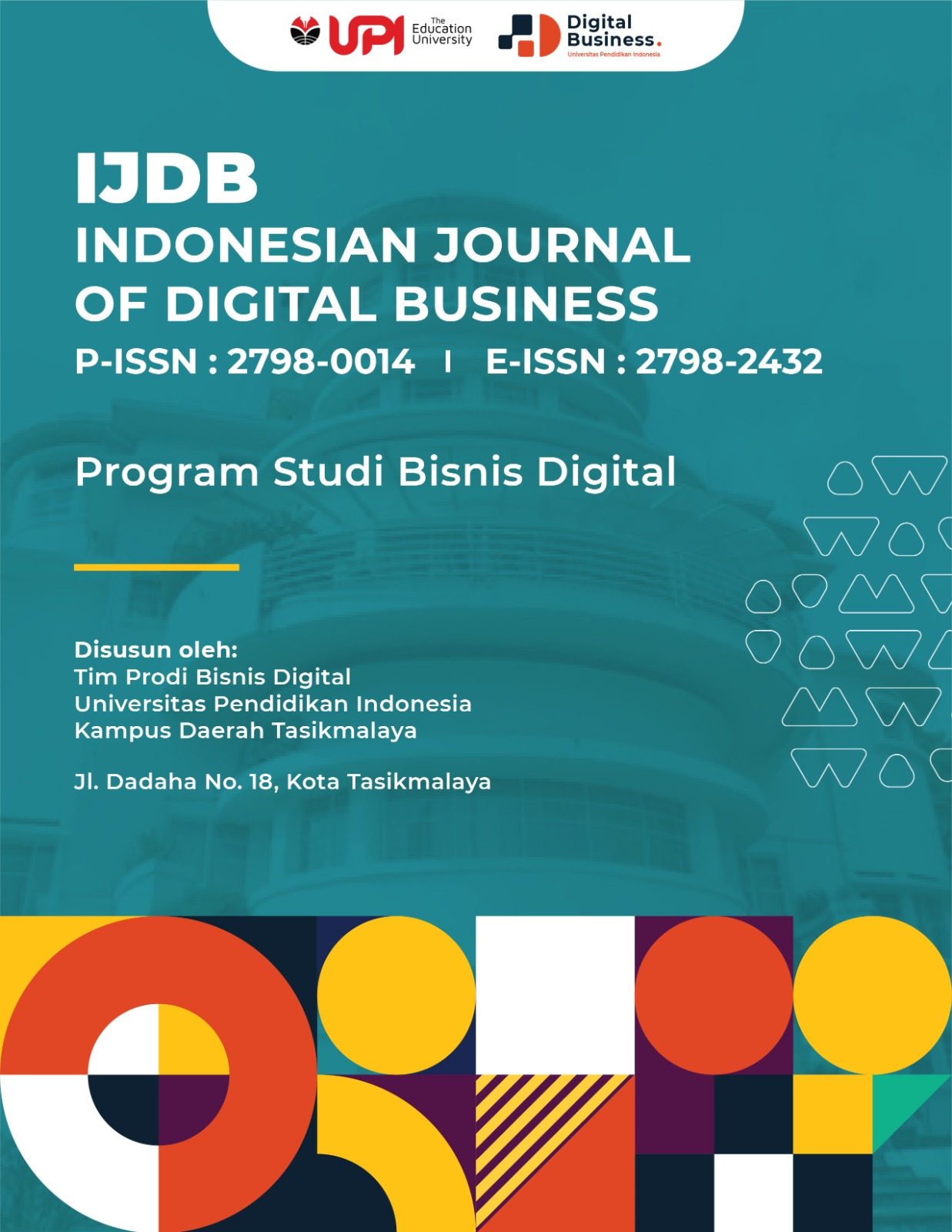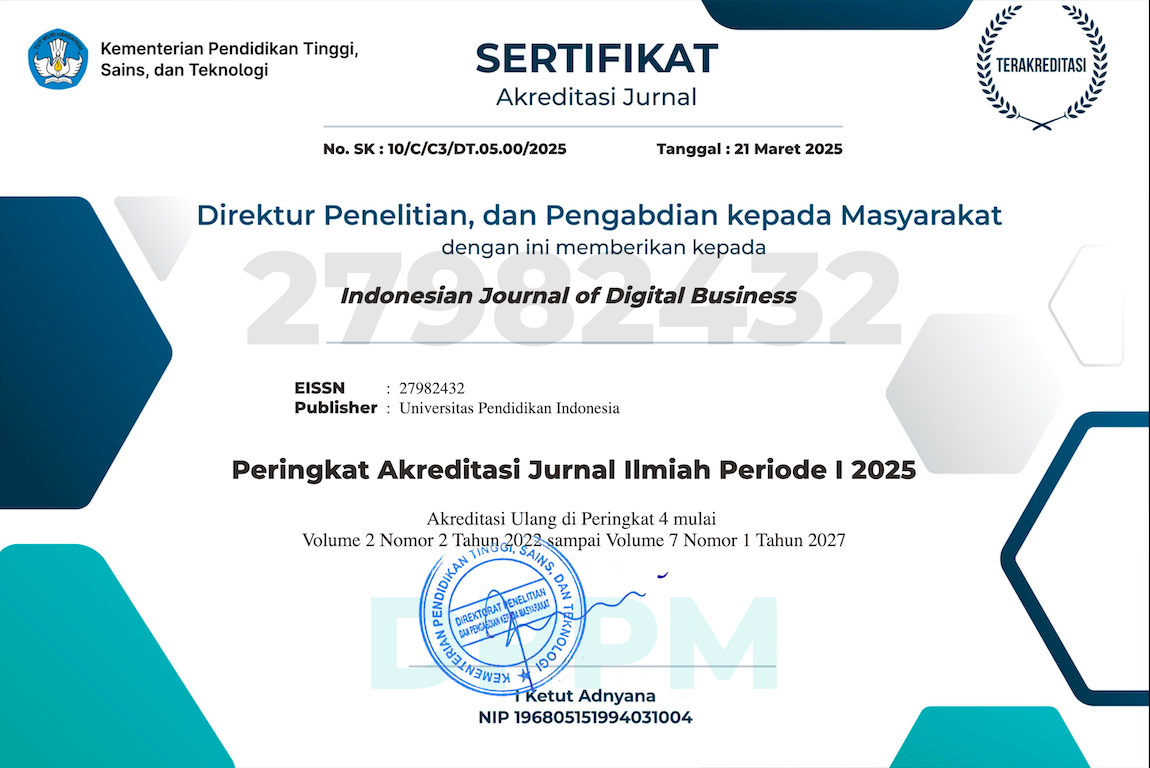Pengembangan Model UTAUT2 yang Diperluas untuk Administrasi Pajak Digital Berbasis Blockchain guna Meningkatkan Kepatuhan Pajak
Abstract
Penelitian ini bertujuan untuk mengembangkan dan menguji model UTAUT2 yang telah diperluas, khususnya dalam konteks adopsi teknologi blockchain dalam sistem administrasi perpajakan digital di Indonesia. Dalam model ini, tiga konstruk utama yaitu ekspektasi usaha (effort expectancy), persepsi risiko (perceived risk), dan kebiasaan (habit) diintegrasikan untuk menjelaskan pengaruhnya terhadap niat perilaku (behavioral intention) wajib pajak dalam mengadopsi teknologi blockchain. Pendekatan kuantitatif diterapkan melalui survei yang melibatkan 50 responden wajib pajak yang telah berinteraksi dengan sistem perpajakan digital. Analisis data dilakukan menggunakan metode Partial Least Squares Structural Equation Modeling (PLS-SEM) untuk menilai hubungan antar variabel yang diuji. Hasil penelitian menunjukkan bahwa hanya ekspektasi usaha yang memberikan pengaruh positif dan signifikan terhadap niat perilaku wajib pajak, sementara persepsi risiko dan kebiasaan tidak menunjukkan dampak yang signifikan. Temuan ini menyoroti pentingnya pengembangan sistem yang mudah dioperasikan dan ramah pengguna untuk mendorong niat adopsi, serta menunjukkan perlunya upaya edukasi dan pembiasaan yang lebih intensif terhadap sistem berbasis blockchain. Penelitian ini memberikan kontribusi penting terhadap pengembangan sistem perpajakan digital yang lebih responsif dan adaptif terhadap kebutuhan pengguna, serta memberikan wawasan bagi pembuat kebijakan dan pengembang teknologi untuk merancang sistem yang lebih efisien dan diterima oleh masyarakat.
Keywords
Full Text:
PDFReferences
Al-Saedi, K., Al-Emran, M., Ramayah, T., & Abusham, E. (2020). Developing a general extended UTAUT model for M-payment adoption. Technology in Society, 62(January), 101293. https://doi.org/10.1016/j.techsoc.2020.101293
Alagoz, S. M., & Hekimoglu, H. (2012). A Study on Tam: Analysis of Customer Attitudes in Online Food Ordering System. Procedia - Social and Behavioral Sciences, 62, 1138–1143. https://doi.org/10.1016/j.sbspro.2012.09.195
Alalwan, A. A. (2020). Mobile food ordering apps: An empirical study of the factors affecting customer e-satisfaction and continued intention to reuse. International Journal of Information Management, 50(April 2019), 28–44. https://doi.org/10.1016/j.ijinfomgt.2019.04.008
Alalwan, A. A., Dwivedi, Y. K., & Rana, N. P. (2017). Factors influencing adoption of mobile banking by Jordanian bank customers: Extending UTAUT2 with trust. International Journal of Information Management, 37(3), 99–110. https://doi.org/10.1016/J.IJINFOMGT.2017.01.002
Algharabat, R., Rana, N. P., Dwivedi, Y. K., Alalwan, A. A., & Qasem, Z. (2018). The effect of telepresence, social presence and involvement on consumer brand engagement: An empirical study of non-profit organizations. Journal of Retailing and Consumer Services, 40, 139–149. https://doi.org/10.1016/J.JRETCONSER.2017.09.011
Alkawsi, G. A., Ali, N., & Baashar, Y. (2020). An Empirical Study of the Acceptance of IoT-Based Smart Meter in Malaysia: The Effect of Electricity-Saving Knowledge and Environmental Awareness. IEEE Access, 8, 42794–42804. https://doi.org/10.1109/ACCESS.2020.2977060
Alomari, M. K., Sandhu, K., & Woods, P. (2021). Predicting Citizens’ Adoption of e-Government Services Using the Unified Theory of Acceptance and Use of Technology (UTAUT). nformation Systems Frontiers, 23, 1–15.
Arendsen, R., & Green, P. (2020). Tax Administration 3 . 0 : The Digital Transformation of Tax Administration Tax Retail Welfare Business Other. Forum On Tax Administration, 1(3), 10–74.
Azmi, A. A. C., Kamarulzaman, Y., & Hamid, N. H. A. (2012). Perceived risk and the adoption of tax e-filing. World Applied Sciences Journal, 20(4), 532–539. https://doi.org/10.5829/idosi.wasj.2012.20.04.2403
Clemes, M. D., Gan, C., & Zhang, J. (2014). An empirical analysis of online shopping adoption in Beijing, China. Journal of Retailing and Consumer Services, 21(3), 364–375. https://doi.org/10.1016/j.jretconser.2013.08.003
DJP, D. J. P. (2020). Cetak Biru Reformasi Perpajakan: Sistem Inti Administrasi Perpajakan (SIAP).
Featherman, M. S., & Pavlou, P. A. (2003). Predicting e-services adoption: A perceived risk facets perspective. International Journal of Human Computer Studies, 59(4), 451–474. https://doi.org/10.1016/S1071-5819(03)00111-3
Haefner, N., Wincent, J., Parida, V., & Gassmann, O. (2021). Artificial intelligence and innovation management: A review, framework, and research agenda✰. Technological Forecasting and Social Change, 162(June 2020), 120392. https://doi.org/10.1016/j.techfore.2020.120392
Hasan, A. A.-T., Sumon, S. M., Islam, M. T., & Hossain, M. S. (2021). Factors influencing online shopping intentions: The mediating role of perceived enjoyment. Turkish Journal of Marketing, 6(3), 239–253. https://doi.org/10.30685/tujom.v6i3.132
Jnaneswar, K. (2022). Unravelling the role of organizational commitment and work engagement in the relationship between self-leadership and employee creativity. Evidence-Based HRM: A Global Forum for Empirical Scholarship, 11. https://doi.org/10.1108/EBHRM-08-2021-0164
Katadata Insight Center. (2022). Laporan Indeks Literasi Digital Indonesia 2022. https://search.katadata.co.id/search?q=Laporan Indeks Literasi Digital Indonesia 2022
Mangoting, Y., Widuri, R., Charlos, D., Dogi, P., & Gabronino, R. (2024). Exploring the Potential of Blockchain Technology in Digital Tax Administration to Enhance Tax Compliance. 26(2), 77–90.
Marr, B. (2016). How Blockchain Technology could improve the tax system. Forbes, December, 1–7.
OECD. (2020). Technology Tools to Tackle Tax Evasion and Tax Fraud. Technology Tools to Tackle Tax Evasion and Tax Fraud. https://doi.org/10.1787/g2g77afa-en
Okumus, B., Ali, F., Bilgihan, A., & Ozturk, A. B. (2018). Psychological factors influencing customers’ acceptance of smartphone diet apps when ordering food at restaurants. International Journal of Hospitality Management, 72, 67–77. https://doi.org/10.1016/J.IJHM.2018.01.001
Pokhrel, S. (2024). BLOCKCHAIN TECHNOLOGY AND THE FUTURE OF TAX ADMINISTRATION: OPPORTUNITIES AND RISKS. Prosiding Seminar Nasional Indonesia, 15(1), 37–48.
Purba, H. (2022). THE ROLE OF LEVEL OF INCOME AND EDUCATION ON DIGITAL DIVIDE: A LOOK AT JAKARTA WORK FORCE. 107–116.
PwC. (2021). Blockchain in Tax and Legal: Driving trust and transparency.
Queiroz, M. M., & Fosso Wamba, S. (2019). Blockchain adoption challenges in supply chain: An empirical investigation of the main drivers in India and the USA. International Journal of Information Management, 46, 70–82. https://doi.org/10.1016/J.IJINFOMGT.2018.11.021
Rejeb, A., Keogh, J. G., & Treiblmaier, H. (2019). Leveraging the Internet of Things and blockchain technology in Supply Chain Management. Future Internet, 11(7), 10–11. https://doi.org/10.3390/fi11070161
Sabri, S., Gani, A., Yadegaridehkordi, E., Othman, S., Miserom, F., & Shuib, L. (2022). A Framework for Mobile Learning Acceptance Amongst Formal Part-Time Learners: From the Andragogy Perspective. IEEE Access, 10, 61213–61227. https://doi.org/10.1109/ACCESS.2022.3178718
Shahzad, K., Zhang, Q., Khan, M. K., Ashfaq, M., & Hafeez, M. (2023). The acceptance and continued use of blockchain technology in supply chain management: a unified model from supply chain professional’s stance. International Journal of Emerging Markets, 18(12), 6300–6321. https://doi.org/10.1108/IJOEM-11-2021-1714/FULL/XML
Susanti, A., Rahmawati, R., & Siregar, M. (2022). Evaluasi Implementasi Teknologi Blockchain di BUMN: Studi Kasus pada Sistem Informasi Keuangan. Jurnal Sistem Informasi, 18(2), 113–126.
Swargiary, K. (2024). An Application of the UTAUT2 Model. May. https://doi.org/10.20944/preprints202405.0210.v2
Venkatesh, V., Morris, M. G., Davis, G. B., & Davis, F. D. (2003). User Acceptance of Information: Towar a Unified View. MIS Quarterly, 27(3), 425–478. https://www.jstor.org/stable/30036540
Venkatesh, V., Thong, J. Y. L., & Xu, X. (2012). Consumer acceptance and use of information technology: Extending the unified theory of acceptance and use of technology. MIS Quarterly: Management Information Systems, 36(1), 157–178. https://doi.org/10.2307/41410412
Wang, Y., Han, J., & Beynon-Davies, P. (2020). Understanding Blockchain Technology for Future Supply Chains: A Systematic Literature Review and Research Agenda. Management: An International Journal.
DOI: https://doi.org/10.17509/ijdb.v5i1.83233
Refbacks
- There are currently no refbacks.
Copyright (c) 2025 Universitas Pendidikan Indonesia (UPI)

This work is licensed under a Creative Commons Attribution-ShareAlike 4.0 International License.
Indonesian Journal of Digital Business is published by Universitas Pendidikan Indonesia (UPI)
and managed by Department of Digital Business
Jl. Dr. Setiabudi No.229, Kota Bandung, Indonesia - 40154
View My Stats





1.png)